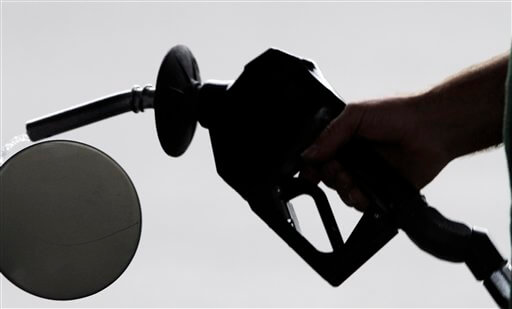
Soaring gasoline prices are in the rearview mirror.
For the first time in months, retail gasoline prices have fallen below $3 a gallon in places, including parts of Michigan, Missouri and Texas. And the relief is likely to spread thanks to a sharp decline in crude-oil prices.
The national average for regular unleaded gasoline is $3.51 per gallon, down from a high of $3.98 in early May. Last week’s plunge in oil prices could push the average to $3.25 per gallon by November, analysts say.
Economist Philip Verleger equates it to “a stimulus program for consumers,” leaving them more money for clothes, dinners out and movies. Over a year, a 50 cents-per-gallon drop in gasoline prices would add roughly $70 billion to the U.S. economy.
Arthur De Villar, a 48-year-old safety inspector for the Federal Aviation Administration, paid $2.96 for gasoline near his home in Manchester, Mo., a suburb of St. Louis — and he recently replaced his SUV with a four-door sedan.
With three boys at home between the ages of 11 and 14, the money De Villar saves on gas still gets spent. But it goes to the amusement park, a Cardinals baseball game or the movie theater.
“It’s far better to be able to put (the money) anywhere other than in the gas tank,” he says.
Prices for oil, gasoline and other commodities dove last week along with world stock markets over concerns the global economy is headed for another recession. When economies slow, demand for gasoline, diesel and jet fuel falls as drivers cut back on trips, shippers move fewer goods and vacationers stay closer to home. Oil fell to $79.85 per barrel Friday, a drop of 9 percent for the week. Oil reached a three-year high of $113.93 on April 29.
Economists caution that gasoline savings, while welcome, won’t matter much to people if the worst economic fears come to pass.
“Yes it produces some relief, your bill at the gas pump goes down, but it’s going down because there are worries that people won’t have jobs,” says James Hamilton, an economics professor at the University of California, San Diego. “The news has not been good.”
And gasoline prices remain historically high. Gasoline has averaged $3.56 this year, the highest yearly average ever. Americans have cut back driving in the face of high prices, but they are likely to spend more on gasoline in 2011 than ever before — close to $490 billion, according to Tom Kloza, chief oil analyst at the Oil Price Information Service.
Kloza says the latest drop in prices will stick around through most of the fall. And while that may only add $20 a month to a typical commuter’s wallet, drivers say it matters.
Pat Wolf, 60, a retired information technology professional from East Lansing, Mich. responded with a “Holy Mackerel!” when he got a text from his wife Friday morning that said a station nearby was selling gas for $2.98 per gallon.
Wolf said prices in the area were $3.49 earlier in the week and he had no hope that they’d fall below $3. “It’s one other thing in the back of your mind if you are deciding whether to buy some gizmo or other,” he says.
Aureleano Duran, a house painter in Dallas, gave the cashier at a RaceTrac gas station $55 to fill up his red Dodge pickup Friday night, but the tank began to overflow before he shut off the nozzle — at $49.21. Duran plans to sock away roughly $30 a week in gas savings. “I’m trying not to spend a lot of it,” he said. Then he excused himself: “I’ve got to go get my change.”
Gasoline prices have always varied from state to state, but the gap now is especially big. Drivers along the coasts are paying significantly more than drivers in the middle of the country, analysts say. California drivers are paying the highest average price in the lower 48 states, at $3.89 per gallon on Sunday. Missouri drivers are paying the least, $3.21 per gallon, according to AAA, OPIS and Wright Express.
Differences in state taxes explain much of the gap. Another factor is that most of the oil used by refineries on the coasts comes from overseas, making it far more expensive than oil piped to refineries in the middle of the country from places such as North Dakota and Canada. The coastal refineries must compete with the growing economies of Asia for shipments of oil.
Patrick DeHaan, senior petroleum analyst at GasBuddy.com, says that while he expects the national average to fall to between $3.25 and $3.50 between now and Thanksgiving, some areas could hit $2.50. He says prices in Lansing, Mich., and St. Louis had fallen below $3 already. A price war between filling stations near Bridge City, Texas, pushed prices to $2.62 last week.
“In some of these areas prices are collapsing,” DeHaan says.
The trend could reverse, analysts say, if the world economy does not descend into recession. That’s because the growth in oil demand from China and other developing nations will more than make up for falling demand in Europe and the United States.
The investment bank Goldman Sachs forecasts that oil will rise to $120 per barrel within the next six months. That’s a jump of 50 percent from last week’s closing price of just under $80 per barrel.
“Whatever we see gas prices falling to, it won’t be the new normal. It will be a launching pad for winter and spring prices,” says Kloza, from Oil Price Information Service.
AP Business Writer David Koenig contributed to this report from Dallas. Jonathan Fahey can be reached athttp://twitter.com/JonathanFahey






























